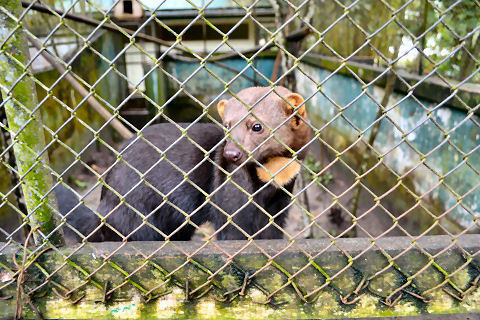While I was in Indonesia I made a visit to an animal project called Animal Friends Jogia in Yogyakarta
 |
| Dog runs at the centre |

 |
| One of the major campaigns is against the dog meat trade |
 |
| Ina's wish list! |
 |
| With Ina at the centre |
It's run by Ina, an Indonesian woman with a passion for animals - it's not so much a rescue centre (although they have about 20 dogs) as an organisation to promote the rights of animals Her main aims are to stop the dog meat trade, to encourage rescue rather than purchase and of course promoting neutering
 | ||
Momkeys and owls for sale at a local market
|
Indonesians and many other Asian people do not see the point of neutering and population control - there is not a culture of preventative medicine here - very little parasite control or vaccination either - the animal organisations here face a real uphill struggle with not only people's attitudes but government bureaucracy to fight.
 |
| Some dogs come in bad condition - thin with chronic skin disease |
It was that government bureaucracy that prevented me from doing short term volunteer work in both Indonesia and Malaysia...
I wish Ina all the best with her endeavours
I wish Ina all the best with her endeavours
 |
| Ear cropping is still common here - this dog has had recent surgery |
 |
| Sterilidation campaigns are a large focus |
While in the capital of Sabah Kota Kinabalu I got the opportunity to visit IAPWA - International Aid for the Protection & Welfare of Animals www.iapwa.org

Set up a few years ago by an English veterinary nurse it's a dynamic and busy neutering project for the street dogs of KK There are 4 permanent Malaysian staff and a team of volunteers vets and nurses who stay here for up to a year They are doing great work and seem to be going from strength to strength.
 |
| Puppies and the centre |
 |
| Outdoor ward... |
 |
| Admission sheet |
 |
| Katie the vet injecting a bitch before spaying |
 |
| Livvy Sharilyn and Rachel |
 |
| All neutered aniimals are tattooed... |
 |
| amd ear notched |

Technical stuff now... as in Central America they flank spay - knocking down with a triple combo of xylazine morphine & ketamine. An IV catheter and ET tube are placed. Anaesthesia is maintained with propofol as necessary
They have a team of catchers who go out and trip the dogs They are kept at the centre for 48 hours in case they are owned - if not claimed they are neutered and if all is well released the day after!






























